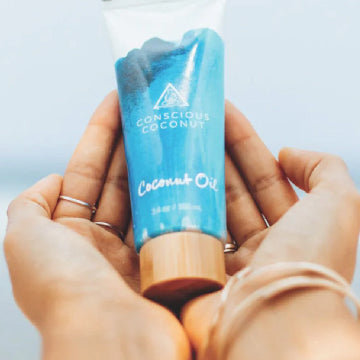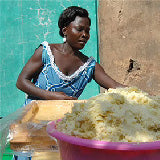Beauty Secrets from Around the World
The fancy beauty products we all know and obsess over that line the shelves of every Sephora, CVS or Ulta may have been created in a lab by people wearing white coats. However, the history behind many of the ingredients used in these "miracle treatments" today stem from various parts of the globe that they are indigenous to, often times thousands of years ago.
Come take a journey with me as I travel through seven countries or regions to reveal how women from Japan to Bulgaria have taken care of their hair and skin since the beginning of time.
Middle East

Many women in the middle east and across the Mediterranean don’t just wear kohl-black eyeliner for the fun of it. This sultry look stems from the ancient Egyptians who believed kohl had antibacterial properties that prevented eye infections including conjunctivitis and boosted the body’s production of nitric oxide, which strengthens one’s immune system. Kohl-painted eyes also help reflect the sun, which is why football players apply it under the eyes during games. For your own kohl-infused look, Lyda Beauty has a Cleopatra Cat Eye Stamp eyeliner, and it’s one of the only Halal certified American beauty brands (meaning its formulation is permissible according to the Qur’an).
Iran

For generations, Persians have used sedr, a green lotus powder that hails from the Ziziphus plant. Sedr cleans hair while it also strengthens and volumizes. To try this on your own, simply add water to your sedr until it turns into a green paste and leave on your hair for 10-20 minutes before rinsing out. According to JOON Haircare Founder,Shiva Tavakoli,you can also add a few drops of JOON Saffron Hair Elixir to the paste for added hydration, which contains the Persian hair strengthening sand smoothing staples of Saffron, Pistachio and Rose.
Japan

Japanese women, known for their youthful, toned and porcelain complexions, have a few interesting tricks of their own. It’s noted that as early as the Nara period (710-794), Japanese women were exfoliating with adzuki beans crushed into a fine powder to achieve a fresh, healthy glow and combat clogged pores. Adzuki beans contain saponin, a natural foaming agent that makes these little red beans more than just food. Moisturizing and antioxidant rich Camellia oil, exfoliating rice bran and skin-brightening Yuzu oil are other natural indigenous ingredients Japanese women consider the fountain of youth. Silktage Pure Japanese Fusion Oil combines all three of these oils into one rejuvenating serum.
India

What do the women of India reach for when they have dry skin? Pure almond oil. Rich in vitamin E, monounsaturated fats, potassium, zinc and copper, this miracle liquid has been revered for ages in the Indian culture. Shalini Vadhera, Global Beauty Expert and author of Passport to Beauty says explains it’s easy to make your own at home since many commercial almond oils have preservatives. Take a handful of fresh almonds, blanch them, and let them dry.
Grind them in the food processor, then put them in a fine sieve and press with a spoon until the oil is released. Place in a small bottle and refrigerate. (This oil can turn rancid very quickly if left at room temperature). Massage oil onto skin after your shower or bath; and use a few drops on your face after cleansing at the end of the day.
Korea

When it comes to Korean beauty secrets, your mind might automatically go to the 10-step skincare regime that took over the internet a few years ago. But ask any Korean about the one true beauty ritual steeped in Korean culture and it’s a good hard body scrub. Exfoliating dead skin cells called ddeh from head to toe is serious business for Koreans. Weekly communal bathhouse visits are a common practice in South Korea where guests strip naked, soak in hot water and receive a scrub or ‘seshin” with a thin, sandpaper-like towel. More rough than relaxing, the result of removing dead skin to bring one’s soft, fresh pink flesh to light of day is considered rejuvenating by many. Mimic this no-nonsense technique on your own with these exfoliating bath washcloths.
China

Gua sha (pronounced “gwahshah”) is the Chinese word for scrapping, which is exactly what this ancient East Asian practice does. Using a tool to apply pressure and scrape the skin, gua sha helps relieve pain and tension in the body, leaving behind light bruising. In traditional Chinese medicine, everyone has chi, the energy that flows through one’s body. When that chi gets blocked, it causes pain and needs to be gua sha’d away. According to Dr. Elizabeth Trattner, A.P., as we’re constantly looking for ancient remedies for modern healthy and beauty benefits, gua sha has become more popular than ever, especially for lifting and sculpting the face. “I have had patients literally have their face transformed by gua sha in one session,’ says Trattner. “It can lift and sculp the face, improve blood circulation, help TMJ, reduce puffiness and drain the lymph, reduce fine lines, and create a healthy glow.” Click here for your own gua sha tool and tips on how to expertly bring this ancient practice into your own beauty regime.
Bulgaria

The pink roses that decorate the 87-mile Balkan mountain range called Rose Valley in May and June each year are an immense source of pride for the Bulgarian people. Distilling rose oil has created a huge industry for this country since the 17thcentury when a Turkish merchant is said to have brought them to their country, and Bulgarian roses are considered some of finest in the world. Many cosmetic products including soaps, shampoos, creams, lotions and toners are created with the intention of touting this liquid gold. What does this stuff really do, though? The essence of Bulgarian rosescontains highlyhealing properties that reduce redness and irritation, treat dermatitis, acne and eczema. It also acts as an anti-inflammatory, reduces the appearance of scars. and calms and refreshes the skin after cleansing. The rose toner in Thracian Bulgarian Rose Water is steam-distilled in one of oldest still -functioning distilleries in Bulgaria.














